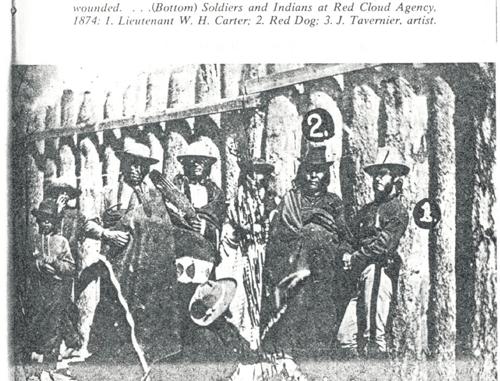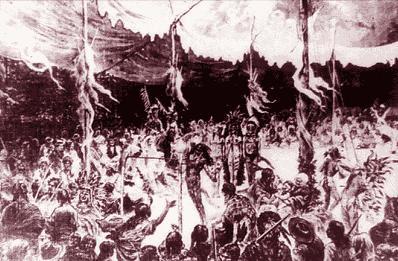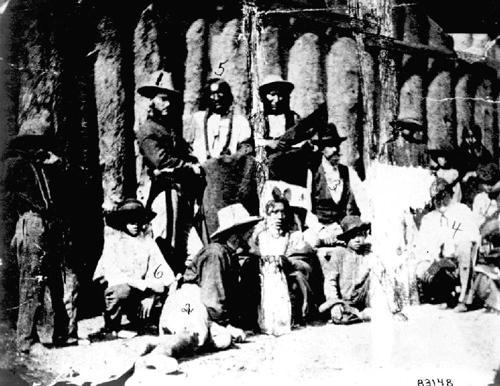Thomas
Wilhelm, Photographer

Note
the presence of the artist, Jules Tavernier, who, along
with Paul Frenzeny, produced several sketches of Indian
life in the west, including the one below of the Sun
Dance at Red Cloud. —
Grahame Wood


This
is a great photo, because it shows Red Leaf, the Wazhazha
chief. I think it's the only known picture of him
(if you can proof me wrong please, please post it!)
although I know that Stanley Morrow must have photographed
him (as it is shown in his catalogue listing): 1. Lt.
Carter 2. Tavernier 3. Dear (indian trader) 4. Lt. Buchanan
5. Red Leaf
I
don't know exactly, but I think I read that the indian
in your photo on the far left is also Red Leaf.
— Dietmar Schulte-Möhring

The
1874 photographs above were taken by Lieutenant Thomas
Wilhelm, 8th Infantry, in the spring of 1874, shortly
after the establishment of Camp Robinson and Camp Sheridan
near the White River agencies.
Wilhelm,
who was adjutant for the 8th Infantry and an amateur
photographer, requested permission to visit the agencies
where several companies of his regiment were stationed.
He travelled with artist Jules Tavernier from Cheyenne
to Fort Laramie, then to Fort Fetterman, and finally
to Camp Robinson, accompanying Captain Stanton, the
department paymaster (since travel in this region was
very dangerous during this time).
Two
people were most instrumental in helping Wilhelm obtain
photographs. James W. Dear, one of two Indian traders
at Red Cloud (his store was located on the west side
of the agency; Frank Yates, brother of Captain Yates
7th Cav, operated the store on the east side) made introductions.
Also Lieutenant William H. Carter, also a member of
the 8th Infantry, helped.
The
two tintypes were taken inside the compound or corral
of J. W. Dear's store at the Red Cloud Agency (not at
Camp Robinson -- remember, did not become known as Fort
Robinson until 1878). You will notice that one of the
images is reversed -- as happens in some tintypes depending
upon the type of camera. Wilhelm presented both of these
images to Lieutenant Carter in appreciation for his
assistance; Carter later donated them to the National
Archives along with his life-time collection of military
memorabilia. All of the copies you see, credited to
the Nebraska State Historical Society and elsewhere,
are just copies of the original two tintypes at the
National Archives.
After
several years of searching, I have accumulated considerable
detail on Wilhelm, including his diary for the period,
but so far have not found any additional examples of
his images.
In
regards to the drawing, yes, that is Tavernier's sketch
of the sun dance that occurred in the early summer of
1874. This was reputedly one of the first among the
Oglala to which whites were allowed to attend; during
the course of the ceremony, lightning struck the central
sundance pole and that was taken as a sign that the
Wakan Tanka disapproved of the "outsider's"
presence! The best account of this sundance is in William
H. Carter's published piece about his experiences at
Camp Robinson in 1874.
Tavernier
did not leave an account of his experience in Nebraska
as far as we know. He did write a letter from Cheyenne
to his family in Europe just prior to departing for
Red Cloud, but I am not aware of any describing his
trip. Incidentally, Tavernier was traveling with another
artist at the time, however, the letters reveal that
Paul F. did not accompany Tavernier on his side-trip
to the Red Cloud Agency. —
Ephriam Dickson